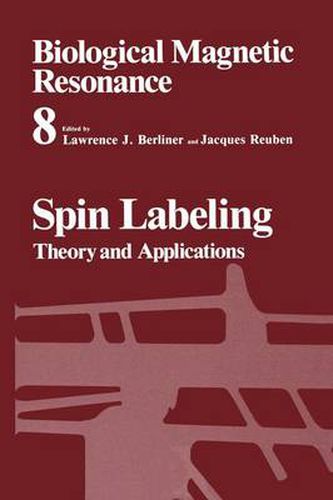Readings Newsletter
Become a Readings Member to make your shopping experience even easier.
Sign in or sign up for free!
You’re not far away from qualifying for FREE standard shipping within Australia
You’ve qualified for FREE standard shipping within Australia
The cart is loading…






This title is printed to order. This book may have been self-published. If so, we cannot guarantee the quality of the content. In the main most books will have gone through the editing process however some may not. We therefore suggest that you be aware of this before ordering this book. If in doubt check either the author or publisher’s details as we are unable to accept any returns unless they are faulty. Please contact us if you have any questions.
We present this special topics volume on an area which has not received thorough coverage for over 12 years. Spin Labeling: Theory and Applications represents a complete update on new theoretical aspects and applications of the spin-label method. In the line-shape theory sections, we are especially pleased to include an IBM-compatible diskette supplied by David Schneider and Jack Freed which contains fast, accurate, ready-to-use software for slow-motion simulations. Barney Bales discusses inhomogeneous broadening phenomena in detail. Several developments in techniques and interpretation in saturation transfer spectroscopy have appeared since the publica tion of Spin Labeling II: Theory and Applications (L. J. Berliner, ed., Academic Press, 1979). We have included an up-to-date chapter on spin-label applications by M. A. Hemminga and P. A. de Jager. By incorporating 15N and deuterium into nitroxide spin labels, several unique advantages are derived in line-shape analysis. Albert Beth and Bruce Robinson have contributed a detailed chapter on the analysis of these labels in the slow-motion regime while Jane Park and Wolfgang Trommer present the advantages for specific biochemical examples in our applications section. Derek Marsh’s contri bution on spin-label spectral analysis may be regarded as a summary chapter which touches on several of the detailed spectral analysis methods described in the earlier chapters.
$9.00 standard shipping within Australia
FREE standard shipping within Australia for orders over $100.00
Express & International shipping calculated at checkout
This title is printed to order. This book may have been self-published. If so, we cannot guarantee the quality of the content. In the main most books will have gone through the editing process however some may not. We therefore suggest that you be aware of this before ordering this book. If in doubt check either the author or publisher’s details as we are unable to accept any returns unless they are faulty. Please contact us if you have any questions.
We present this special topics volume on an area which has not received thorough coverage for over 12 years. Spin Labeling: Theory and Applications represents a complete update on new theoretical aspects and applications of the spin-label method. In the line-shape theory sections, we are especially pleased to include an IBM-compatible diskette supplied by David Schneider and Jack Freed which contains fast, accurate, ready-to-use software for slow-motion simulations. Barney Bales discusses inhomogeneous broadening phenomena in detail. Several developments in techniques and interpretation in saturation transfer spectroscopy have appeared since the publica tion of Spin Labeling II: Theory and Applications (L. J. Berliner, ed., Academic Press, 1979). We have included an up-to-date chapter on spin-label applications by M. A. Hemminga and P. A. de Jager. By incorporating 15N and deuterium into nitroxide spin labels, several unique advantages are derived in line-shape analysis. Albert Beth and Bruce Robinson have contributed a detailed chapter on the analysis of these labels in the slow-motion regime while Jane Park and Wolfgang Trommer present the advantages for specific biochemical examples in our applications section. Derek Marsh’s contri bution on spin-label spectral analysis may be regarded as a summary chapter which touches on several of the detailed spectral analysis methods described in the earlier chapters.